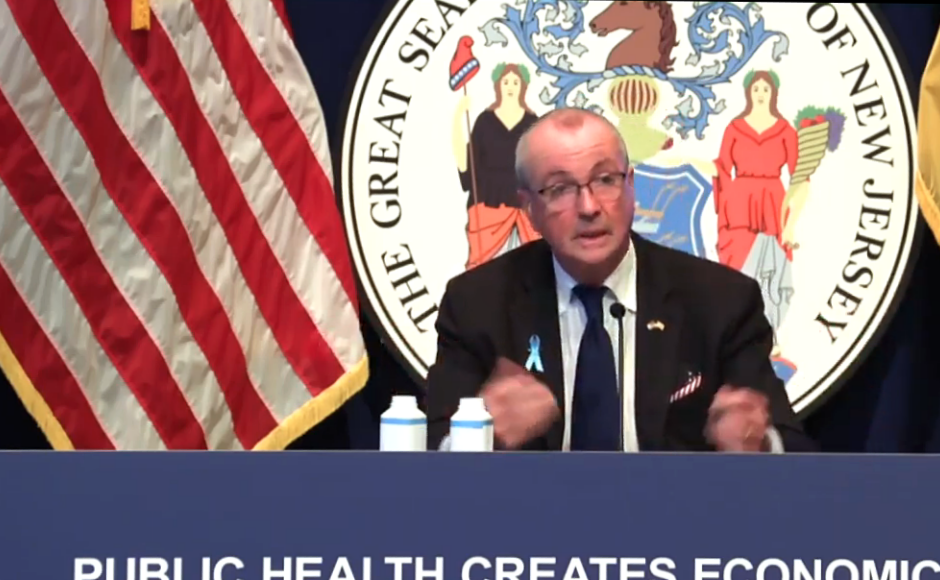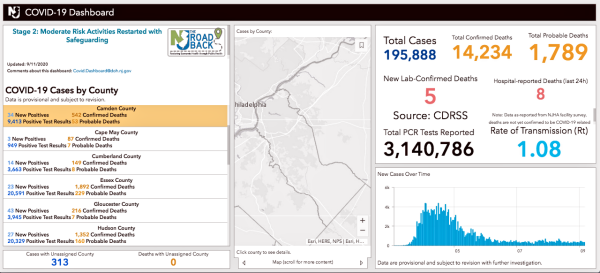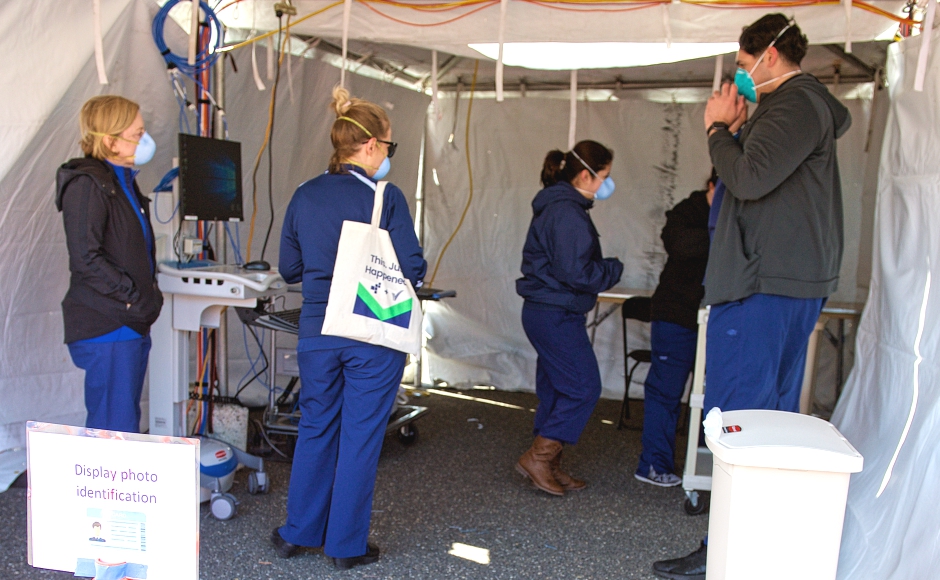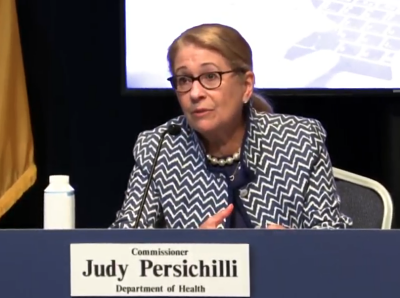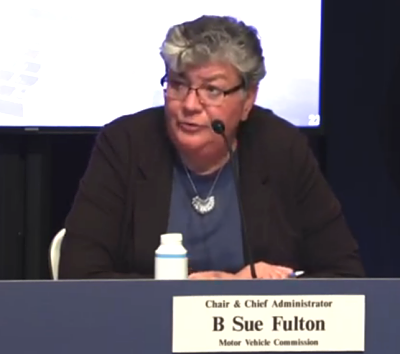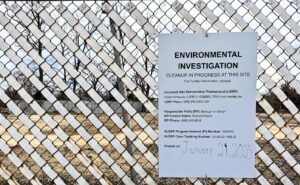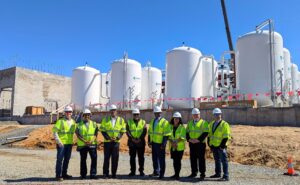Plus: no school-related COVID-19 cases have been reported yet in New Jersey, and improvements to motor vehicle commission workflow continue to reduce wait times and in-person transactions.
By Matt Skoufalos | September 11, 2020
Another 518 New Jersey residents have tested positive for novel coronavirus (COVID-19), bringing the statewide total to 195,888 cases, Governor Phil Murphy reported Tuesday.
Sadly, nine more residents have perished from complications related to the virus, bringing the statewide death toll to 14,234 lives lost during the pandemic.
In addition to those lab-confirmed fatalities, the state has acknowledged another 1,789 probable COVID-19-related deaths, up by six from prior totals.
In the past six months, 260 of every 100,000 New Jersey residents have been hospitalized with COVID-19, and 162 of every 100,000 have died from COVID-19-related complications.
More than 3 million people have been tested for the virus statewide, with a 2.2-percent positivity rate per 100,000 residents.
Rate of transmission (Rt) at 1.08, spot positivity at 2.60 percent statewide
The statewide average of COVID-19 spot positivity testing stood at 2.60 percent September 7.
In South Jersey, it was slightly lower, at 2.44 percent.
Rt, the variable that describes the seven-day, rolling-average rate of transmission of new COVID-19 cases, hit 1.08 from samples taken September 9.
An Rt figure greater than 1.0 means that each new COVID-19 patient is infecting more than one other person, on average, and the spread of the virus is increasing.
Since its mid-April COVID-19 spike, the highest reported RT in New Jersey was 1.48, recorded August 1. The lowest was 0.62, recorded June 9.
Long-term care accounts for half of all deaths, a fifth of those infected
Throughout New Jersey, 482 people currently are hospitalized with a case of COVID-19: 240 have tested positive for COVID-19, and 242 are awaiting confirmation of their symptoms.
New Jersey Health Commissioner Judy Persichilli noted, however, that the latest hospitalization tally includes “a number of duplicates” discovered by the state communicable disease service, so those figures will likely be revised downward.
Among those hospitalized patients, 81 are in intensive or critical care, and 36 of the ICU and critical-care patients (44 percent) are on ventilators.
Across the state, 684 long-term care (LTC) centers have reported at least one case of COVID-19, and 156 are dealing with an active outbreak. LTCs account for 38,347 infected patients and staff in New Jersey, or 20 percent of total cases.
That includes 24,938 residents and 13,409 staffers sickened by the virus, as well as 7,127 lab-confirmed resident and staff deaths (50 percent of the statewide total), with facilities self-reporting 121 staff deaths.
Of 656 veterans residing in a state-run home, 388 residents have tested positive for COVID-19, and 146 have died from complications related to the virus. Nine veterans presently are hospitalized with COVID-19, and 242 have recovered from the virus.
At state-run psychiatric facilities, 213 of 1,190 patients and 517 staff members have tested positive for COVID-19. Thirteen patients and seven staffers have died from complications related to the virus.
To date, 57 New Jersey children aged 1 to 18 have been diagnosed with pediatric multisystem inflammatory syndrome, Persichilli said.
All those pediatric patients have tested positive for an active COVID-19 infection or the presence of COVID-19 antibodies, indicating exposure to the virus. No deaths have been associated with this syndrome in New Jersey, although several children have been hospitalized during their treatment.
Young people account for highest COVID-19 positivity rates in NJ
New Jersey residents aged 14 to 24 now account for the highest COVID-19 positivity rates in the state, Persichilli said.
Six percent of those aged 19 to 24 are COVID-19-positive, most of any age group in the state, and those aged 14 to 18 are right behind them, at 4 percent positivity.
“Among all other age groups, [positivity rates are] declining or flat,” the commissioner said.
Those percentages began to climb in mid-August, as end-of-summer and back-to-school parties “are helping to drive transmission,” Persichilli said. Health officials are also seeing increases among college students living off-campus. She urged those demographics to take precautions when they gather.
“We know we are all social beings; we know young people want to socialize, but it must be done safely,” Persichilli said.
New Jersey has not yet recorded any cases of COVID-19 transmission originating in schools, she said. Families must be notified if someone at their child’s school tests positive, or if their child has been in contact with someone who’s tested positive. Any positive test within the school must be reported to the county health department, Persichilli said.
Contact tracing update
New Jersey has added another 66 contact tracers to its ranks, bringing the total to 1,835 across the state.
That makes an average of nearly 21 contact tracers per 100,000 residents, Murphy said; 20 of 21 counties in the state have at least 15 contact tracers for every 100,000 residents.
However, a significant number of those notified of their potential exposure to a COVID-19-positive person are still declining to participate in the contact tracing process. Murphy said that 18 percent of those called don’t answer the phone, and 59 percent of those reached refuse to provide further contacts.
In order to alleviate their fears, Persichilli said that contact tracers are trained to offer additional supports, including help with housing, shelter, job protection, child care, or other needs.
“People don’t want to rat out their friends because they’re concerned for their friends’ welfare,” she said. “Will they have to leave work? Will they have to quarantine for a few weeks? Who will feed their kids? Will they be taken care of?
“It’s both [that] they just don’t want to give the names, and some real reasons because of quarantine measures,” the commissioner said.
NJMVC works to cut wait times, move transactions online
New Jersey Motor Vehicle Commission (NJMVC) Chief Administrator Sue Fulton said that the agency continues to work to clear backlogs attributable to the pandemic, as well as trimming wait times for those who must appear in person to conduct their business.
Newly enacted measures mean drivers only need retake their license photos once every 12 years, while photos of those aged 65 and older will be valid “indefinitely.”
Those actions alone will alleviate the need for 220,000 people to appear in person at an MVC center through the end of the year.
In-person transactions are still required for those seeking new driver licenses and commercial driver licenses, as well as for handling out-of-state document transfers, and private sales of used cars.
“These transactions require us to examine documents and confirm people’s identities to prevent fraud,” Fulton said, while acknowledging, “these lines are still too long.”
Average waits for tests and inspections are down to pre-COVID levels (15 to 30 minutes), she said, but they could increase as extended deadlines expire.
Last year, 40 percent of registrations and 20 percent of license renewals were conducted online, Fulton said; those numbers jumped to 70 percent and 55 percent, respectively, since the agency began offering expanded online payment options and vehicle-related transactions.
Fulton urged residents to avoid camping out overnight at NJMVC agencies, and asked them to conduct their business on weekdays, if possible, to get same-day service.
At 36 of 39 facilities across the state, those arriving by 8 a.m. are typically served the same day, she said. Based on average wait times, only three centers would require residents to arrive earlier than that: Newark (6 a.m.), South Plainfield (7:12 a.m.), and Wayne (6:45 a.m.).
“No one needs to stand in line all day,” Fulton said. “Tickets are distributed at 8 a.m. based on capacity for the day. You get a ticket and leave your phone number.”
Fulton also said that “lines outside are not necessarily a sign of dysfunction inside,” but are a byproduct of social-distancing measures that involve queuing up outside rather than inside the building.
“We just can’t cram 100, or 200, or 300 people into the agencies like we used to,” she said. “And just because no one isn’t standing outside in the afternoon doesn’t mean we’re not serving customers all day.”
Finally, of 1,200 NJMVC employees, only four have tested positive for COVID-19 since facilities reopened, and two of those people work in the same agency, Fulton said.

